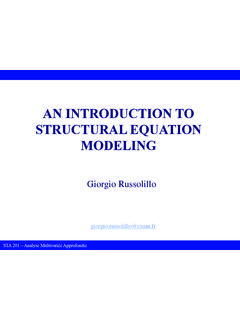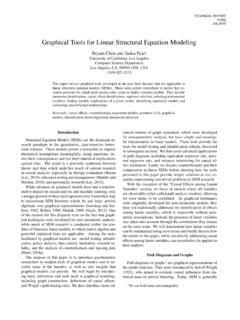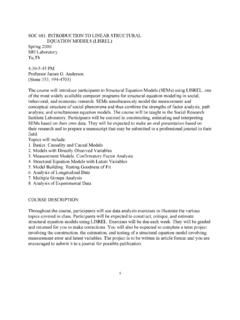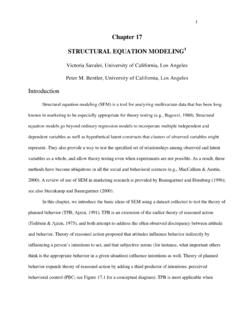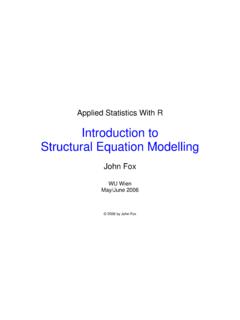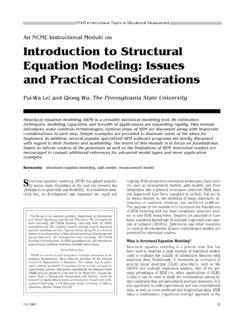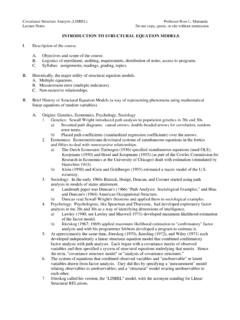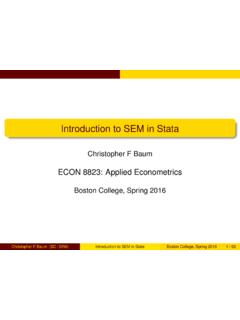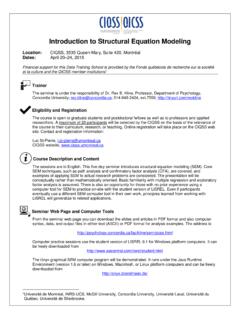Transcription of Latent Variable and Structural Equation Modeling for ...
1 Latent Variable and Structural Equation Modeling for Health Sciences P8158 CLASS SESSION Wednesday 8:50 AM - 11:20 AM Location: Hammer 312 INSTRUCTOR Dr. Melanie M. Wall Professor Depts of Biostatistics and Psychiatry COURSE DESCRIPTION This course is designed for those students (or any researchers) who want to gain a significant familiarity with a collection of statistical techniques that target the measurement of Latent variables ( variables that cannot be measured directly) as well as methods for estimating relationships among variables within causal systems. This course covers exploratory and confirmatory factor analysis, item response theory models, Latent class and finite mixture models.
2 The course also covers Structural Equation Modeling including its directed acyclic graphical notation as a means to estimate assumed causal relationships in the presence of confounders, mediators and moderators. Data analysis examples will come from health science applications and practical implementation of all methods will be demonstrated using predominately the Mplus software, but also the R software. PREREQUISITES A one year course in applied statistics at the level of 6103-6104 or permission of the instructor. COURSE LEARNING OBJECTIVES Students who successfully complete this course will be able to: Understand the Latent Variable measurement problems that can and cannot be addressed using factor analysis and item response theory models Be able to implement factor analysis and item response theory models using software on real data and interpret results including checking model assumptions Understand the use of Latent class and finite mixture models as methods for clustering individuals and be able to fully implement them using software including assessing model fit and interpreting results Understand the role of Structural Equation Modeling (SEM)
3 Including its directed acyclic graphical notation as a means to estimate assumed causal relationships including the role of confounders, mediators and moderators. Identify and be able to estimate using software the total, indirect, and direct effects within a SEM as well as assessing model fit and checking model assumptions. Critically read research articles that use the collection of methods learned in the course. 2 ASSESSMENT AND GRADING POLICY Student grades will be derived from a combination of homeworks (50% of grade), one in-class exam (25% of grade) and a group final project (25% of grade including written and oral presentation).
4 Homework: Homework is due in class on date specified. Homework turned in after the time it is due will have 50% deducted. You may only turn in late homework up until the next homework is due, after that there will be no credit given. In-class exam: The in-class exam will be open notes. Group Final Project: Depending on the size of the class groups for final projects will be of size 2-4 students and will be formed by self-selection. For all projects, a written report (6-8 pages not including graphs) outlining the problem, describing the analysis and summarizing the results will be required. The results will be presented to the class orally (15-minute presentation) during the last week of class and possibly during the time slot set aside for finals.
5 Grading of the project will be as follows: 2/3 of the project grade will come from the written report and 1/3 will come from your presentation. Everyone in the group will get the same grade on the project, no attempt at partitioning credit to one member over the other will be accepted. The project will entail ONE of the following three options: Option 1: A substantive description and detailed statistical analysis of some data set in which the analysis utilizes any of the statistical Modeling techniques learned in class. Option 2: A detailed description and critique of a published paper in which a Latent Variable or Structural Equation Modeling technique was employed.
6 Option 3: Perform a simulation study or provide some analytical results for a statistical method for Latent Variable or Structural Equation Modeling . The grading scale based on the Total percentage is the following and is meant to reflect the Mailman School of Public Health qualitative descriptions at: 93-100 A , 90-92 A-, 85-89 B+, 78-84 B, 75-77 B-, 70-74 C+, 65-69 C, 60-64 C- A grade of A+ will be reserved for highly exceptional achievement and will not necessarily be given every semester. For those taking the course S/N (Pass/Fail), an S will be earned if a grade equivalent to a C- or above is achieved.
7 For all students, if a grade of at least C- is not achieved, the grade will be F (or N). COURSE REQUIREMENTS There is no textbook assigned for this course. Course notes will be made available on a weekly basis through the class website by the instructor and will serve as the primary source of course material. Weekly assignments will consist of reading course notes or reading a selected article and performing a data analysis. The course notes for each week will be posted on the CourseWorks site; they range in length from 40 to 60 pages. Assigned articles will also be available on CourseWorks; these range from 10 to 15 pages.
8 You can anticipate about 4 hours of work outside class for each of the data analyses. 3 You will need access to a computer (either your own or in a lab where you can download statistical software). I will be introducing how to implement all the techniques in the course using the Mplus software ( ) . A FREE demo version of MPLUS software is available for download from the Mplus website. Some very good resources (including full video lectures by the creator of Mplus, Bengt Muthen) can be found at the Mplus website COURSE STRUCTURE Classroom experience will be a lecture with notes made available electronically before class and demonstration of computer code and output using the free demo version of Mplus or freely available R software.
9 Homework will be assigned approximately every other week and students may discuss their work with other class-mates but are expected to write-up results themselves. Week 1 Introduction to scope of the course Learning Objectives: Survey the full range of Latent Variable and Structural Equation Modeling methods that will be introduced in the course. Assignment: Homework I Find a research article on your own that uses any of the methods we will cover in the course and provide a critique, describe the main goal of the paper and the method use and something you did not understand and would like to learn more about.
10 Week 2 Fundamental ideas of Measurement Learning Objectives: Learn how to develop conceptual variables. Understand reflective vs. formative Latent variables. Understand and know methods for assessing dimensionality, reliability, and validity of scales. Required Reading: Course Notes Related Reading: Scientific Advisory Committee of the Medical Outcomes Trust: Assessing health status and quality of life instruments: attributes and review criteria. Quality of Life Research 2002; 11: 193-205 Diamantopoulos A and Siguaw J (2006) Formative versus reflective indicators in organizational measure development: A comparison and empirical illustration, British Journal of Management, 17, 263-282.










